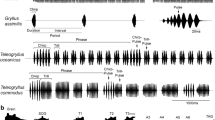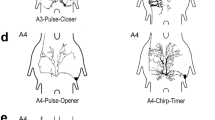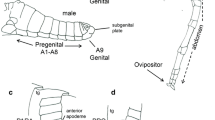Summary
In the grasshopperChorthippus biguttulus the stridulatory movements of males with surgically manipulated ventral nerve cords were investigated.
-
1.
The stridulation pattern of animals with a hemisected mesothoracic ganglion was indistinguishable from that of intact animals.
-
2.
After hemisection of the metathoracic ganglion several animals were still able to stridulate in the species-specific pattern (Figs. 3, 5). Different structural elements of the song, however, were affected to different degrees by this operation. Although the stereotyped up-and-down movements were normal, the rhythm of pauses, which in intact animals are inserted after every third to fourth up- and-down cycle, was disturbed. As a result, the variation of syllable lengths was much higher (Fig. 4).
-
3.
A prominent feature after hemisection of the metathoracic ganglion was an almost complete loss of coordination between left and right hind legs (Figs. 5–7). Only in the coarse structure of the song (e.g. the beginning and termination of song sequences) was a correlation of the leg movements still discernible. This was especially obvious in songs of the rivalry type and in precopulatory kicking movements (Fig. 8).
-
4.
If in addition to hemisection of the metathoracic ganglion one of the neck connectives was transected the animals stridulated only with the hind leg ipsilateral to the intact connective (Fig. 11).
-
5.
Even after hemisection of both the meso- and metathoracic ganglia, animals were able to produce the species-specific stridulation pattern (Fig. 9).
-
6.
In animals with hemisected metathoracic ganglia and both connectives between pro- and mesothoracic ganglia transected, components of the species-specific pattern could be induced by current injection into the mesothoracic ganglion (Fig. 10).
-
7.
These results suggest that the stridulation rhythm-producing neuronal network is composed of hemisegmental subunits. A hemiganglionic structure of rhythm generators might reflect the ancestral organization of locomotion-controlling networks.
Similar content being viewed by others
Abbreviations
- CNS :
-
central nervous system
- TG1 :
-
prothoracic ganglion
- TG2 :
-
mesothoracic ganglion
- TG3 :
-
metathoracic ganglion
References
Bentley D (1977) Control of cricket song patterns by descending interneurons. J Comp Physiol 116:19–38
Bässler U (1983) Neural basis of elementary behavior in stick insects. Springer, Berlin Heidelberg New York
Delcomyn F (1985) Walking and running. In: Kerkut GA, Gilbert LI (eds) Comprehensive insect physiology, biochemistry and pharmacology, vol 5. Pergamon, Oxford, pp 439–466
Elsner N (1974) Neuroethology of sound production in gomphocerine grasshoppers (Orthoptera: Acrididae). I. Song patterns and stridulatory movements. J Comp Physiol 88:67–102
Elsner N (1975) Neuroethology of sound production in gomphocerine grasshoppers (Orthoptera: Acrididae). II. Neuromuscular activity underlying stridulation. J Comp Physiol 97:291–332
Elsner N (1983) A neuroethological approach to the phytogeny of leg stridulation in gomphocerine grasshoppers. In: Huber F, Markl H (eds) Neuroethology and behavioral physiology. Springer, Berlin Heidelberg New York, pp 54–68
Elsner N, Huber F (1969) Die Organisation des Werbegesanges der HeuschreckeGomphocerippus rufus L. in Abhängigkeit von zentralen und peripheren Bedingungen. Z Vergl Physiol 65:389–423
Elsner N, Popov AV (1978) Neuroethology of acoustic communication. Adv Insect Physiol 13:229–355
Friesen WO (1985) Neuronal control of leech swimming movements: interactions between cell 60 and previously described oscillator neurons. J Comp Physiol A 156:231–242
Friesen WO, Poon M, Stent GS (1978) Neuronal control of swimming in the medicinal leech: IV. Identification of a network of oscillatory interneurones. J Exp Biol 75:25–43
Graham D (1985) Pattern and control of walking in insects. Adv Insect Physiol 18:31–140
Gramoll S (1988) Activity of metathoracic interneurons during stridulation in the acridid grasshopperOmocestus viridulus L. J Comp Physiol A 163:813–825
Gramoll S, Elsner N (1987) Morphology of local ‘stridulation’ interneurons in the metathoracic ganglion of the acridid grasshopperOmocestus viridulus L. J Comp Neurol 263:593–606
Grillner S, Wallen P (1985) Central pattern generators for locomotion, with special reference to vertebrates. Annu Rev Neurosci 8:233–261
Gynther IC, Pearson KG (1986) Intracellular recordings from interneurons and motoneurons during bilateral kicks in the locust: implications for mechanisms controlling the jump. J Exp Biol 122:323–343
Hedwig B (1986) On the role in stridulation of plurisegmental interneurons of the acridid grasshopperOmocestus viridulus L. I. Anatomy and physiology of descending cephalothoracic interneurons. J Comp Physiol A 158:413–427
Helversen D von (1972) Gesang des Männchens und Lautschema des Weibchens bei der FeldheuschreckeChorthippus biguttulus L. J Comp Physiol 81:381–422
Helversen D von, Helversen O von (1975) Verhaltensgenetische Untersuchungen am akustischen Kommunikationssystem der Feldheuschrecken. I. Der Gesang von Artbastarden. J Comp Physiol 104:273–299
Helversen O von (1979) Angeborenes Erkennen akustischer Schlüsselreize. Verh Dtsch Zool Ges 1979:42–59
Helversen O von, Elsner N (1977) The stridulatory movements of acridid grasshoppers recorded with an opto-electronic device. J Comp Physiol 122:53–64
Huber F (1960) Untersuchungen über die Funktion des Zentralnervensystems und insbesondere des Gehirnes bei der Fortbewegung und der Lauterzeugung der Grillen. Z Vergl Physiol 44:60–132
Huber F (1963) The role of the central nervous system in Orthoptera during the coordination and control of stridulation. In: Busnel RG (ed) Acoustic behaviour of animals. Elsevier, Amsterdam, pp 440–488
Kriegbaum H (1988) Untersuchungen zur ‘Lebensgeschichte’ von Feldheuschrecken (Acrididae, Gomphocerinae): Fortpflanzungsstrategie und akustisches Verhalten im natürlichen Habitat. Thesis, Universität Erlangen-Nürnberg
Kutsch W, Otto D (1972) Evidence for song production independent of head ganglia inGryllus campestris. J Comp Physiol 81:115–119
Pearson KG, Reye DN, Parsons DW, Bicker G (1985) Flight-initiating interneurons in the locust. J Neurophysiol 53:910–925
Robertson RM, Pearson KG (1983) Interneurons in the flight system of the locust: distribution, connections, and resetting properties. J Comp Neurol 215:33–50
Robertson RM, Pearson KG (1985) Neural circuits in the flight system of the locust. J Neurophysiol 53:110–128
Römer H, Marquart V (1984) Morphology and physiology of auditory interneurons in the metathoracic ganglion of the locust. J Comp Physiol A 155:249–262
Ronacher B, Miller S (1986) Localization of neuronal pathways involved in two behavioral reactions in a grasshopper. Naturwissenschaften 73:737–738
Remacher B, Helversen D von, Helversen O von (1986) Routes and stations in the processing of auditory directional information in the CNS of a grasshopper, as revealed by surgical experiments. J Comp Physiol A 158:363–374
Ronacher B, Wolf H, Reichert H (1988) Locust flight behavior after hemisection of individual thoracic ganglia: evidence for hemiganglionic premotor centres. J Comp Physiol A 163:749–759
Stein PSG (1977) A comparative approach to the neural control of locomotion. In: Hoyle G (ed) Identified neurons and behavior of arthropods. Plenum, New York, pp 227–239
Stein PSG (1978) Motor systems, with specific reference to the control of locomotion. Annu Rev Neurosci 1:61–81
Stevenson PS, Kutsch W (1987) A reconsideration of the central pattern generator concept for locust flight. J Comp Physiol A 161:115–129
Stumpner A (1988) Auditorische thorakale Interneurone vonChorthippus biguttulus L.: Morphologische und physiologische Charakterisierung und Darstellung ihrer Filtereigenschaften für verhaltensrelevante Lautattrappen. Thesis, Universität Erlangen-Nürnberg
Treherne JE (1974) The environment and function of insect nerve cells. In: Treherne JE (ed) Insect neurobiology. North-Holland, Amsterdam, pp 187–244
Weeks JC (1981) Neuronal basis of leech swimming: separation of swim initiation, pattern generation, and intersegmental coordination by selective lesions. J Neurophysiol 45:698–723
Weeks JC (1982) Synaptic basis of swim initiation in the leech. II. A pattern-generating neuron (cell 208) which mediates motor effects of swim-initiating neurons. J Comp Physiol 148:265–279
Wendler G (1985) Insect locomotory systems: control by proprioceptive and exteroceptive inputs. In: Gewecke M, Wendler G (eds) Insect locomotion. Parey, Berlin, pp 245–254
Wolf H, Ronacher B, Reichert H (1988) Patterned synaptic drive to locust flight motoneurons after hemisection of thoracic ganglia. J Comp Physiol A 163:761–769
Author information
Authors and Affiliations
Rights and permissions
About this article
Cite this article
Ronacher, B. Stridulation of acridid grasshoppers after hemisection of thoracic ganglia: evidence for hemiganglionic oscillators. J. Comp. Physiol. 164, 723–736 (1989). https://doi.org/10.1007/BF00616745
Accepted:
Issue Date:
DOI: https://doi.org/10.1007/BF00616745




